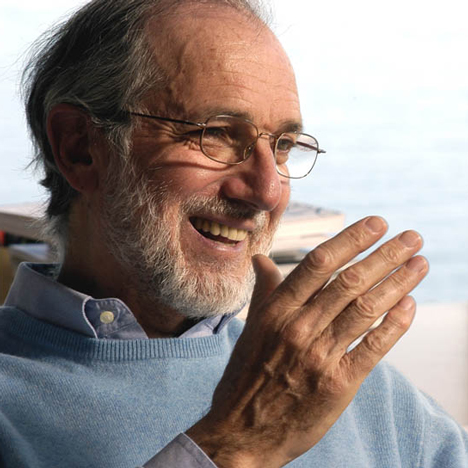
Interview: Renzo Piano on The Shard
As The Shard nears completion in London, here is the transcript of an interview conducted with architect Renzo Piano before work started on the 300 metre-high tower.
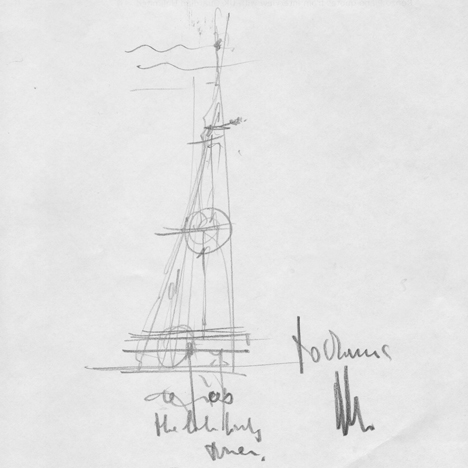
During the interview, conducted by Dezeen editor-in-chief Marcus Fairs, Piano sketched the building (above) that would later become the tallest tower in western Europe, explaining how the design came about, how it got its nickname and why, as an architect, he has always avoided having a recognisable style of architecture:
Marcus Fairs: How did the Shard project come about?
Renzo Piano: It was [Arup structural engineer] Tony Fitzpatrick who called and said do you want to meet somebody? And that somebody was [developer] Irvine Sellar [of Sellar Property Group]. We met in Berlin. I was quite attracted by the idea of… not really of making a tall building, but the idea of making a mixed-use tower – a vertical city.
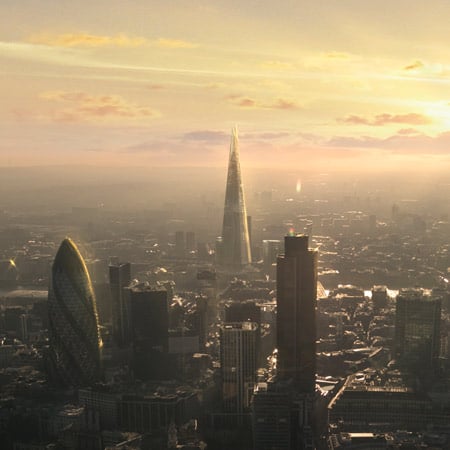
Above: visualisation of The Shard by architectural rendering studio AVR London, as published on Dezeen in 2009.
It was also clear that this tower was sitting in the centre of a crossing system of different transportation – trains, buses and all that. So it was typical of work we have done in the past about brownfields – how to intensity life in the city. The philosophy topping the expansion of the city by explosion and starting implosion. Growth of the city from inside: filling the holes, filling the industrial sites, railway sites. And then we started to work.
So that was the beginning. Why we came up with this [the form of The Shard] is a bit more difficult. The most important thing that attracted us was this idea of mixing use, and the fact that it was sitting in a vital place of interchange. It provided an excellent occasion to show that you could provide life in a city without increasing the traffic – by using public transportation.
The first time I met [then London mayor] Ken Livingstone in London it was clear Ken was happy about this. It fell perfectly within his philosophy. So finally our philosophy, the client’s philosophy, Ken’s philosophy and the city’s philosophy were coming together. It was quite fortunate.
Then the next thing is if you have to put mixed use – if you have to put together office space, hotel space and residential space, you understand very quickly that for the office you need that big platform [gesturing with hands], for the hotel you need that big and for the houses you need that big. So if you need that that and that, what is the shape you end up with?
In some ways it is difficult to clarify between the conscious and the subconscious – between rationality and instinct – but in some way this idea of something starting fat and becoming small was a rational and instinctive process. Rational because it made sense from the beginning. Instinctive because it became clear that the only way to make something elegant was to not fill the sky – to make something slim.
Was the shape a formal decision or did it come through sketching?
No it also came by sketching, and also by making models. I made a joke the first time Irvine came to the office; I picked up in the workshop a shard – not of glass but of wood. A splinter. I made a joke about it. actually it was quite immediate. If I’m not wrong, even that day in Berlin – this may be part of Irvine Sellar mythology – he reminded me last time that during the lunch I picked up a pencil and I started sketching. We talked from the beginning that was quite wide here and then less and less and less [Piano sketches the building on a sheet of paper, below] this idea of doing something that was probably breaking the scale and coming up in this position, having an observation deck here, certainly public space here, housing from here to here, hotel from here to here, office here… this thing came very quickly.
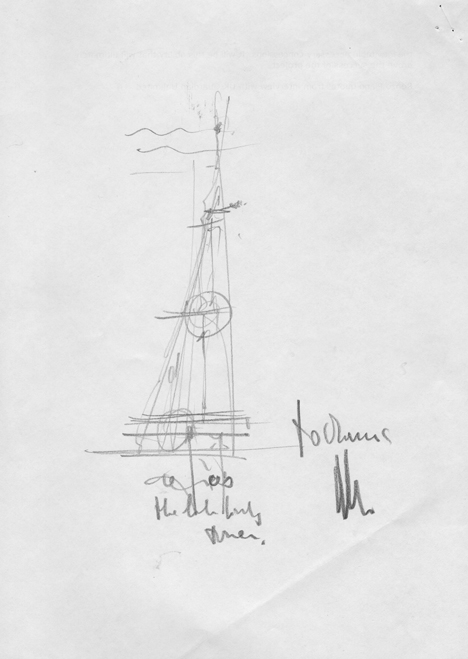
As quickly as you just drew it?
Yeah, something like that. But I don’t want to create a mythology. Then of course it became quite evident from the first sketches that from that height up [indicates upper levels of the building] you have quite a lot of wind and you are not going to be able to use the space when you come down below 50sq m [per floor], so we started to come up with the idea of the radiator [the finned heat-transfer device that topped the building in early iterations but which has since been replaced by a series of public viewing galleries].
It’s a glass building – and glass buildings are not renowned for their energy efficiency.
As you know we are aiming to save a lot of energy. Actually that is what we have done in Sydney; the Aurora Place tower that was finished five or six years ago actually saves one third of the energy by the previous building there. There we used the breeze in the winter garden, and chemicals in the glass. Glass technology has changed immensely.
We are working on different things. One is that because it’s a mixed use, we have extra production of heat from the offices that we can reuse in the residential part. This is un-poetic but it is very intelligent.
The other thing is the composition of the glass. We are working with double glass – actually triple glass – with a space in between where we have lamellas – venetian blinds – that cut heat gain from the sun. And when you don’t have sun – which happens in London – you can lift up the lamella. They are inside the glass. Of course the air between the two panes of glass heats up, but then we evacuate it and reuse it.
So the composition of the façade is part of the mystery, part of the story. And we are working on a chemical glass with a composition… the blinds are better than tinted glass. You can see them. At night they will disappear. There will be some facets that will probably not even have lamella. It’s like the trunk of a tree, acting differently all the way round, depending on how much sun it gets. The south side will not be the same as the north.
We don’t use mirror glass or tinted glass. We use new technology which is more subtle. The language of the building will depend on this. We will use clear glass – low iron glass. It’s also called extra white glass in England. This is very different from regular glass, which is very green. If you use low iron glass you end up with something that really is like a crystal. So depending on the day, the light and the position of the sun, the building will look different. It will not look like a massive glass meteorite - choom! - as many towers do. It’s going to be more vibrant and changing.
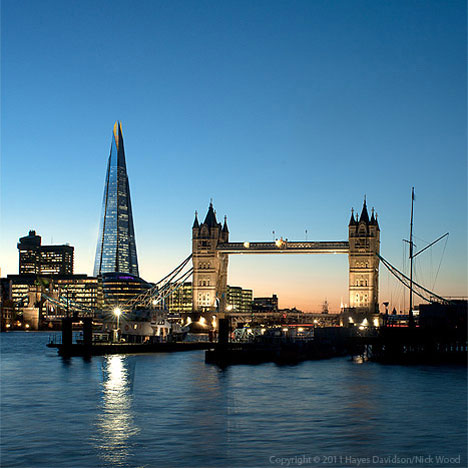
Above: visualisation by photographer Nick Wood and architectural rendering studio Hayes Davidson, one of a series published on Dezeen last year.
How do you ensure that such a tall building compliments, rather than damages, the city it sits in?
That’s a good question. Towers usually have a very bad reputation - and normally a deserved reputation, because they are normally a symbol of arrogance and power. In other words the story towers normally tell are not very nice; not very subtle. They are just about power and money. But the idea of a tower is not just a bad one. In this case the desire to go up is not really to break any record – it is to breathe fresh air. It is to go up to enjoy the atmosphere. So I think the first point about serenity is more that the building is not struggling to be powerful. It’s actually quite gentle. Especially as from the street the building is not like that but is like that, and as a consequence it will reflect the sky.
All this is about doing a building that is not arrogant. I don’t think arrogance will be a character of this building. I think its presence will be quite subtle. Sharp but subtle. This doesn’t mean you have to lose presence and intensity. I think the building will be intense – it’s not timid.
In an interview a few years ago you said “We have to have the confidence to believe that we can create a tower that Londoners will come to respect as they respect St Paul's. The power of Mammon created a beautiful city like Sienna; this power can be put to good civic use, not just to make developers rich.” Do you believe that?
I went through this exercise a number of times including at a conference at the RIBA when everybody was talking about adding towers to London. And I said I don’t think London is a city of towers. I think Manhattan is a city of towers, it makes sense there. I don’t think London is a city of towers and I don’t think the only way of intensifying life in the city is by making towers. I don’t think growth by implosion – rather than explosion at the periphery – necessarily means building towers. The city of London, where the buildings normally making the city are two or three floors, you can easily increase the density of the city without making towers.
In London I don’t see many many places where you can make towers. Also if you build a tower, you cast a shadow. The funny thing is that here our shadow is cast on the river. We don’t cast a shadow …
You are sitting above a great hub of transportation. There are many things that make this building possible there and not somewhere else. I think this is one of the few positions where you can have towers.
But the tallest tower in Europe?
First, Marcus, it will only be the tallest for a few weeks! I’m joking. It’s not the highest because we have been struggling to make it the highest. It’s not the highest when you stop here. We didn’t try to beat any record.
But I think you are touching something very important, which is the discussion about style, the griffe, the recognisable gesture. I believe this is part of the star system of architects but its not a good story for architecture because it doesn’t celebrate architecture but celebrates the architects. I think in the end is not good for architecture because in the end it limits the freedom. You as an architect – let's assume you have a certain success; you are always pushed to repeat yourself. It’s not just true for architects; it’s also true for painters, writers, film makers. If you do something, people will ask you to do it again. But this is not a good story; this is a lack of freedom.
Everybody talks about a lack of freedom but probably the most difficult freedom to keep is not from other people but from yourself. Freedom from other people is quite easy; if you have a tough group of people working together as we are – honestly, we defend our freedom quite well – but the most dangerous freedom to defend is the one with yourself. Because you get used, you become self-referential, because things go well. So you fall in the big trap, which is the one of recognisable signature. The idea that you do things this way. So immediately people say that is Pierre Cardin, Hermes or whatever. I’m not saying this to be a moralist; I hate this idea of a repetitive gesture or a self-referential attitude; I hate this idea of being trapped by the need to promote your griffe – your label – but at the same time I love the idea of coherence. I love the idea that an architect has their own language. We have to constantly fight against the temptation to repeat yourself.
Above: timelapse movie by architectural photographer Paul Raftery and director Dan Lowe that shows the final stages of The Shard's construction, published on Dezeen earlier this week
You come from a family of builders. How did this affect your architecture?
Architecture is not construction. Architecture is art, but art vastly contaminated by many other things. Contaminated in the best sense of the word – fed, fertilised by many things. But I came to this attitude that architecture is art starting as a builder.
And this was good because it kept me away from academia when I was young. When you are young as an architect you are always in danger of falling in to the trap of academia. Academia is the attitude to make shape without knowing enough about the bottom part of the iceberg. But if you become more humble – in 62 and 63, I was sleeping more in the university of Milan than in my bed. It is true, I came from a family of builders but I also came from a very strong social experience of community life. Living with other people, changing the world, sleeping on the bloody bench in the university. So this funny mix, this funny bouillabaisse of emotion is very rich.
So it’s stupid to say that coming from a family of builders was a good thing in itself because you can learn later on, but it was good because it kept me away from formality. From academia, from the easy pleasure of creating form.
Academia not just in architecture but writing, painting, music – everything that is done without rebellion. And when you are young it is very dangerous. When I was young student, the Italian system was highly academic. Like in France. France now is different; but don’t forget the École des Beaux-Arts has been spoiling architects for ages. Creating pseudo-artistic architects. So in some way my origins of a builder family kept me away from this. And it kept me away from being too easily trapped in the pleasure of gesture.
The Centre Georges Pompidou [the building Piano won at competition with Richard Rogers in 1971, launching both of their careers, and which famously features service pipes and ducts on the outside] could have been such a style trap for you.
At first, people think you will spend your entire life making pipes! And they ask you to make pipes. This is also true for artists. If you take a great artist like Giacometti, for example. Giacometti spent the last ten years repeating the same thing – because he was asked to repeat the same thing. The poor guy – he was so nice and gentle that he did. It was not nasty – he was not doing it to make money or whatever, it was just a trap he fell in.
Architecture is by definition a discipline – of course it is artistic, it is scientific, social discipline – but it is a discipline where the adventurous side is very strong, because every job is a new adventure. This is a completely different adventure from making the Paul Klee museum in Bern. It is completely different. How can you tell such a different story with the same language? How can you worry about that? But you don’t have to worry if you have an internal coherence. This will come anyway. But if you start worrying then you fall in the trap. Instead of being free, you worry that is not essential, which is “how will people recognise that it is mine”.
What is your internal coherence?
Marcus, I don’t care but people keep telling me that they recognise it. There was a guy who went to see one of our buildings but he didn’t know it was one of ours. If there is something there that is coherent… if you ask me what are the traces of this, I think more than always using the same material, always the same rhythm, it is more about a desire for lightness for example, for transparency, for vibration.
It’s not so different from what we are trying to do with the New York Times [building in New York, which features a curtain wall of ceramic tubes]. The poetic desire behind this is similar – it’s about vibration, about becoming part of the atmosphere, metamorphosis. Lightness, transparency, maybe tension between the place and the built object.
There are certain characteristics. I don’t think I should worry about it, but some critics tell us and they normally talk about this – the emotion of a space being built up also by immateriality. This is not my idea –[architecture critic] Rayner Banham discussed the well-tempered environment. The idea that architecture is sometimes built up by immateriality: light, transparency, long perspective, vibration, colour, tension. I prefer to dig in this quarry rather in the repetition of certain gestures.
Look, I was lucky enough to be educated when I was a young architect in Milan to explore the cities, to put my hand into science, utopia, to change the world. That’s the kind of thing you do when you are young – rebellion. Don’t forget, rebellion, when you are young, is the cheapest way to find yourself. However, how can you accept when you are 60 years old the humiliation of having a style. Of being grabbed by commercial obligation. It’s a humiliation; it’s insulting. As an architect this is what you have to aim [for]. This kind of freedom – maybe you will never change the world but you have to believe you can otherwise you are lost.
So every time you get a new job, the way you approach it is by saying ah… but how can you humiliate yourself by saying no, no, no, forget it; first, how can we make ourselves recognisable.
So if someone came to you and said “I want a building with pipes on the outside”, what would you say?
I would laugh. You know there is a moment in your life when people don’t come any more to say silly things like that. We are in a very privileged position to be able to decide what to do.
But a challenge like this has a very deep root in the history of a city, in the history of science, so there is a kind of utopia here. It’s not just a formal gesture. Even the little idea of a vertical city, mixed use, intensify life without adding new cars. You realise we have forty-seven cars in this building [The Shard]. The car park is for forty-seven cars! Not 4,000. This is also because Ken Livingstone also said don’t even add … just for handicapped people and that kind of use.
So there are many many things here that are the invisible parts of architecture. It’s a bit like an iceberg. The invisible part is what I call the social vision for a city, the context and things like that. It’s very strongly there. Unless you do this, architecture becomes very quickly an academic exercise; a formal exercise.
Many people claim the Centre Georges Pompidou was the first building in the “high-tech” style. Was that building a formal exercise?
In reality it is quite an ironic building. It is not a real spaceship – it is a Jules Verne spaceship. It’s really more a parody of technology than technology. It was just a direct and quite innocent way to express the difference between the intimidating cultural institutions like they normally were in the 60s and 70s - especially in this city [Paris, where his studio is based] – and the modern building, very open and a curious relationship with people. The idea was that it doesn’t intimidate. We were young bad boys and we liked that.
But the Beaubourg is not really the triumph of technology. It’s more about the joy of life. It’s a rebellion.
Are you still rebellious?
Mmmmmm. in some ways yes. But you should not ask me, you should ask my wife.
See all our stories about Renzo Piano »